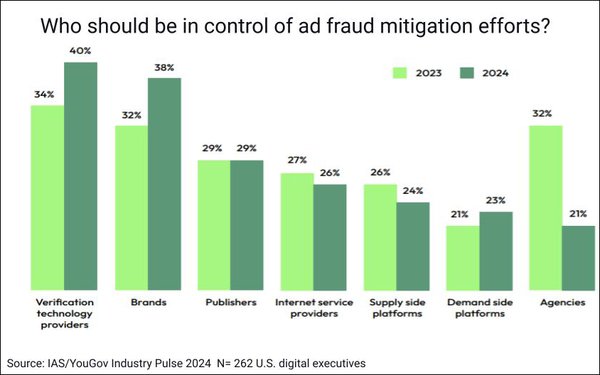
Digital pros on the buy side of
programmatic advertising view the potential for ads being delivered alongside risky content or misinformation as the biggest media challenge in the year ahead, according to the latest annual U.S.
Industry Pulse survey from Integral Ad Science/IAS and YouGov.
Adjacency concerns were cited by 28% of brand, agency and ad-tech executives, although that was closely followed by decreased
access to consumer data/cookies (27%), challenges in assessing campaign results (26%) and difficulty/confusion in buying/selling programmatic media (24%).
Other buy-side media concerns include
contextual targeting, ads adjacent to political content, ad fraud and poor viewability levels (chart above).
The survey of 262 digital media experts who use programmatic, including executives
from brands (75), agencies (78), ad-tech firms (53) and publishers (56), was fielded in September.
advertisement
advertisement
With the 2024 election in view, publishers also cited ads being placed next to risky
content/misinformation as their top media concern (29%).
Asked which media are most vulnerable specifically to brand risk, most experts by far cited social media (54%), followed by
mobile (25%), digital display (23%) and search (22%).
Asked which media are most vulnerable to ad fraud, social was also the top choice by far (60%), followed by digital display (29%), mobile
(22%) and digital video/CTV (22%).
Asked which media they are prioritizing in the year ahead (three responses allowed), more than two-thirds (67%) of all the executives cited social media,
followed by digital video/CTV at 37%. Digital display and mobile came in at 29% and 26%, respectively.
Most also identified social media and digital video/CTV as the media they think are on
one hand most likely to face serious challenges in 2024, and on the other, most promising in terms of potential for innovation:


When it comes to media quality priorities for 2024, digital pros as a
whole are prioritizing viewability (83%), brand-risk mitigation (80%), attention (79%) and contextual targeting (79%). The percentages citing these among just brands and agencies were even higher.
Asked who should be in control of brand risk mitigation efforts, 37% of executives overall said brands (up from 35% in last year’s survey), versus 34% saying agencies, 29% publishers and 28%
verification technology providers.

Asked
who should be in control of ad fraud mitigation efforts, verification tech providers and brands were cited nearly equally (by 40% and 38%, respectively).
